What causes Brain Freeze?
Why are we looking for earth-sized planets? Can I unshrink a woollen jumper? What does a black hole actually look like? Chris Smith is joined by David Rothery, Anna Ploszajski, Aimee Eckert and Michael Conterio to answer your science questions.
In this episode
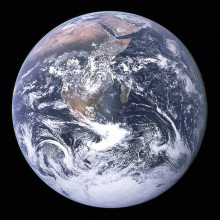
06:23 - Why are we looking for Earth-sized planets?
Why are we looking for Earth-sized planets?
We put Sasha's question to our captain planet: David Rothery.
David - There is something special about the size of the Earth, Sasha, but we’re not searching specifically for Earth sized planets, we’re searching for any planets around other stars that we can find, and most of them are giant planets like Jupiter because they’re the easiest ones to find. If one of those goes in front of a star it cuts out more of the star’s light, for example.
But we are now beginning to find Earth sized planets transiting (going in front of their stars), and causing a tiny dip in the brightness and that is what get’s people most excited, and that’s what hits the news. Just about ten days ago there was a story broke with seven Earth-sized planets orbiting a star known as Trappist-1. We’ve known about three of them for a couple of years actually, and four more have taken the total up to seven. That was very exciting. It was a red dwarf star; seven Earth sized planet. At least three of them are going to have the right temperature for there to be liquid water on the surface. So it’s a place where life that we understand could form, and where life as we understand would be detectable by means that we have.
Nobody’s saying you’re not going to get life in the clouds of a Jupiter like planet but that is entirely speculative. So, if we want to find life elsewhere, the most sensible place to focus on to begin with, at least, is planets that look similar to the Earth. Then at least we have a chance of looking for something that we could recognise.
Chris - One point that was made to me this week in the wake of this discovery was that because those small planets are so close in to that host star which is, as you say, not much bigger than Jupiter they will, therefore, become what we call tidally locked. So they’ll always show the same face to that star in the same way that we always see the same face of the Moon, and that will mean that one side of those planets is going to be roasting hot or nice and warm, the other side very, very cold. So it’s not going to be ideal and not like the Earth at all, potentially.
David - Unlike the Earth in that respect, this tidal locking is because it’s a small dim, red star, and to be at the right distance from it to be warm enough you’ve got to be very close and you get tidally locked. But that doesn’t mean one side is roasting hot and the other side is absolutely freezing.
If it has an atmosphere and some circulation, the heat would be distributed around the planet so you could have life all over the place. No sunlight, no starlight on the far side but there are ways to feed off chemical energy. So they are in the habitable zone of temperature we believe is conducive to liquid water, and if you've got the right chemistry you can have life. So being tidally locked - most of our life-bearing planets in our galaxy could be these Earth like planets around red dwarf stars, tidally locked. We could be the unusual case; not the norm. We don’t know yet. It’s exciting that we’re beginning to find out.
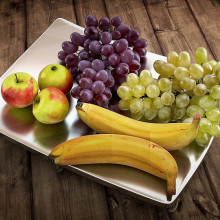
09:19 - Why 5 daily vegetable portions has become 10?
Why 5 daily vegetable portions has become 10?
with Aimee Eckert, University of Sussex
A new study carried out by Imperial College London and published in the International Journal of Epidemiology suggests that eating 10 portions of fruit and vegetables leads to an increase in life expectancy and a reduction in heart disease and cancer risk. Biologist Aimee Eckert, from the University of Sussex, explains the work to Chris...
Aimee - So there’s been a heck of a lot of confusion over how exactly much fruit and veg we should all eat and if any particular types were especially beneficial because a lot of companies like to use the health benefits of vegetables for marketing so-called superfoods and what have you.
What this group of researchers did, they did something really cool, it’s called a meta-analysis. That’s basically pooling a lot of similar studies together in order to really detect benefits or harms of different things. So in this particular instance, looking for if there’s any real benefit of eating more fruit and veg, and they found that eating more fruit and veg was beneficial up to a point. And they found that, overall, eating up to 800 grams of vegetables a day, so that’s the equivalent of maybe ten portions. Or another way to visualise 800 grams is about the size of a loaf of bread. That much vegetable a day provided the maximum possible benefit against heart disease, cancer, and general mortality, but any more than that made no real difference to mortality.
So eating more fruit and vegetables is good but that that benefit doesn’t increase exponentially. So if you eat kilos of vegetables you’re not going to live forever.
Chris - Is it that if you say eat five, people will eat two? If you say ten, you have a half chance that maybe people will eat enough?
Aimee - Yes. I think one of the intimidating things for me is I get confused about what a potion is. A potion is maybe less vegetables than you might imagine. I often envision piles of broccoli when I hear headlines like oh you must eat ten portions of fruit and veg, but 80 grams might not be too much. It could be that I’m a massive fan of putting vegetables in my curry, or I’m a big fan of frozen peas, or the frozen vegetable section, for example.
Chris - I’m a big fan of shiraz. Can I include wine in my five a day - ten a day?
Aimee - I think so!

11:43 - Could I survive in a falling elevator by jumping at the last second?
Could I survive in a falling elevator by jumping at the last second?
We put Addie's question to physicist Michael Conterio...
Michael - This is quite a shame because when I was young I had this exact same question. It would be brilliant just to be able to jump at the end and save my life but, as it turns out, you can’t, sadly.
If you think about it, if you imagine falling all the way down from a few floors up, and of course you’re building up speed, you’re building up momentum as you go down. And when you reach the bottom, it’s the fact that in order for you to lose all that momentum, the floor basically has to push on you very hard, and it pushes on you so hard that it hurts - it breaks your legs and kills you.
So if you could do a little jump just before you reach the ground you’re not going to be able to get rid of all that momentum. You can only jump a little height compared to how much you’ve fallen. So you wouldn’t have the strength to do it. If you did have the strength to do it, you’d still basically break you legs while doing it. And there’s also the fact that if it’s in freefall, so the life is just dropping, there’s no friction keeping it up or anything, then you would be in freefall as well. That means that the slightest touch on the bottom of the lift you would start drifting away from it. Your acceleration would be slightly different to the lift.
So there’s a big result in general relativity which basically says that being in freefall inside a lift like this is basically the same as being out in deep space and just floating around in a rocket ship, so you’d experience almost like zero gravity while you were falling for those few brief moments.
Chris - I suppose one way you could also look at this is to say that in order to have movement which is equal and opposite to the falling of the lift, you’ve got to jump as fast in the opposite direction the lift is carrying you downwards. So you’ve got to be going upwards at the same speed as the lift would be going downwards and you splatting on the ground. So in order to propel yourself at that rate anyway you’d have to experience the same forces on your legs to accelerate you, wouldn’t you in the first place, so you’d still do damage to yourself achieving a monumental jump like that?
Michael - Yeah. It’s basically the same odds and saying that you’re going to be accelerated to whatever speed you’ve acheived by falling with the lift in the same amount of time as it would take you to jump, which is a lot of force in a very little time.
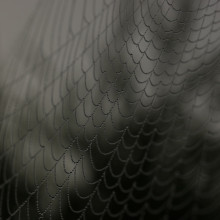
14:40 - Is spider silk the strongest natural material?
Is spider silk the strongest natural material?
We put Joe's tough question to materials scientist Anna Ploszajski, from University College London...
Anna - Spider silk is an example of an exceptional natural material. It’s exceptionally strong and it’s also very, very stretchy. These are two materials properties that we don’t often see come together in a single material. However it is not, unfortunately, the strongest natural material. In February, 2015 it was surpassed by limpet teeth. These can be up to 40 percent stronger than spider silk, and the reason that they’re so strong is that they’re an example of a nano composite.
What we mean by that is that a composite is a combination of two different materials, one of which is at the nanoscale, so very, very, very, very thin. Now this particular material of limpet teeth is made from a protein base and interwoven in that is a dense webbing of very, very tiny nano fibres made from an iron based mineral called goethite. The combination of properties of these proteins and this mineral that give the limpet teeth their incredible strength.
Chris - And they need that incredible strength because?
Anna - Because they’ve got to hang onto rocks no matter what the weather is and no matter what kind of …
Chris - Is it that or is it because they’re scouring stuff off the rocks?
Anna - I’m not actually sure.
Chris - Because they’re grazing, aren’t they, as they go across the rocks surface they’re scraping off algae and things and filtering them into their body?
Anna - OK.
Chris - So I suppose you need something harder than the rock you’re living on otherwise your teeth or going to wear away really fast?
Anna - Indeed. Not only harder but stronger as well. So yeah, the material properties required are pretty intense for these poor little limpets.
Chris - So spiders are trumped!
Anna - Yeah!

16:31 - Do plants have stem cells?
Do plants have stem cells?
Biologist Aimee Eckhart, from the University of Sussex, took on Hong's question...
Aimee - Stem cells are what scientist call - because scientists like big words - undifferentiated cells. And what that means is the cell has the capability to turn into any other type of cell in the body or the organism such as a plant. So, for example, in us we've got heart cells, we’ve got brain cells, stomach cells, skin cells, but they all started life as stem cells.
A nice metaphor I like to think about is: stem cells are a little bit like children, their future is stretched out before them and they have the capability to become whatever career, whatever job they want, and depending on the environment that child is placed in and what education it’s given, then that determines its future.
So stem cells are like children and once they’ve become more specialised, once you choose your job such as a physicist or a radio presenter, it’s much more difficult to break out of that and become something else.
Plants do have stem cells because - and this is important for plants because plants or not like us or animals where they can run away or move away from danger. So if they get eaten or damaged by bad weather they need to be able to regenerate themselves, of course. So yes, in areas of the plants where growth takes place, so shoots and roots, there are stem cells.
Chris - I think they go by the name merry stems don’t they?
Aimee - Yes. That’s the region of the plant tissue where the stem cells are found - yes.
Chris - Good job we have them because Anna was telling us earlier she’s gone vegan and you’d be very hungry if it wasn’t for stem cells growing lots of plants for you to eat.
Anna - That’s absolutely right.
Chris - David?
David - Well if plants didn’t have stem cells wouldn’t they be floppy all over?
Aimee - Well, yes.
David - Boom boom!
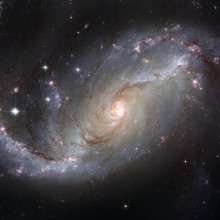
18:49 - What does a black hole look like?
What does a black hole look like?
We put Tim's question to Michael...
Michael - In a way, the clue is in the name. The actual black hole itself will look black - there won’t be any light coming to us from that. But that’s just part of what’s going to be happening around the black hole because, obviously, the gravity around the black hole is quite strong. You’ll have all this other material which is getting sucked up and pulled towards the black hole and, in some cases, orbiting it.
That’s how we recognise that there are black holes already. We haven’t seen one directly so much as seeing the effects of one on other planets of other solar systems, so all of this material swirling around it. It crashes into each other, it gets hot. Hot things will start to give out light and so you’ll see this kind of swirl of light around the black hole.
Of course, this is even more complicated than that because black holes warp space and time around themselves and so around, near the black hole, some of the things that you’ll see when you're looking nearly at it will be stuff that’s behind the black hole. The light that has come from all of the material crashing into each other behind it will bend around the black hole. To the light it seems like it’s going in a straight line - we know light goes in straight line but the actual space is warped around the black hole and so we’ll see some of the light from behind it, and this is called gravitational lensing. In some cases we’ve imaged other galaxies, I believe, from behind black holes or just large concentrations of mass.
Chris - Why is it helpful to be able to see an image and shape of these black holes in this way?
Michael - We’ve got lots of predictions about what is going on in the vicinity of a black hole. Einstein’s general theory of relativity is what we need to use in order to describe a black hole. Basically it's a case to say “have we got this right, can we actually check this against the universe”? Because if we see something that we don’t expect, then our theories are wrong.
Chris - Blimey! That would be a worry, wouldn’t it? Mind you, some physicists say it’s kind of good to be wrong because it shows that you don’t understand everything and it gives you something to aim at. You then know know what the next question is you have to ask.
Michael - There’s a brilliant line I saw Dara O’Brien the comedian give in one of his shows which was “science knows that it’s wrong sometimes because, if it wasn’t, it would stop and that would be it.” It’s always exciting even if you think that the results that you didn’t expect might just be experimental error like the one about neutrinos possibly traveling faster than the speed of light that we had a few years ago. Even when you think that it is a mistake, there’s still a chance that it might be some new physics that we haven’t worked out yet, and that’s really exciting.
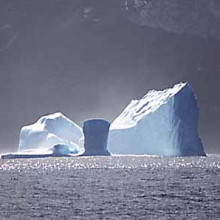
21:57 - Can we drink water from other planets?
Can we drink water from other planets?
Chris put this question to David Rothery from the Open University...
David - Ok Bhavesh, I’m not sure that the purest water is from glaciers but let’s assume it is. Water on the Moon; there is water in permanently shadowed craters near the Moon’s poles. There’s quite a famous paper about that subtitled “Don’t drink the water.”
Chris - Why?
David - It’s probably got cometary volatiles in there as well, so it will have all these organic and carbon bearing molecules as well.
Chris - They presumably haven’t tasted Cambridge tap water lately?
David - But I have and it’s probably worse on the Moon. Titan is going to have methane and ethane tainting the ice. And Enceladus and Europa are going to be all kinds of salts and possibly magnesium sulphate, or epsom salts if it’s hydrated. So if you drink that water you’ll be trotting off to the loo quite soon.
Chris - That’s true because magnesium sulphate is is a pro diarrheal, isn’t it? But there are these people in America, where fracking is going on, that have been able to set light to their tap water with methane and ethane coming up with the water. So I suppose they’re already used to this?
David - Well possibly. But you can’t set fire to the water on Titan because there’s no oxygen from methane to burn with.
Chris - And you couldn't open a nightclub on the Moon either because there’s not atmosphere. But more seriously, if we do go to Mars because one of the really important points that people make is we go to Mars and we’re going to have plenty of water because Mars was once very wet with loads of subsurface water. Could we just dig a hole, pull out some of that ice and drink it?
David - You would want to purify it. Just evaporate it and recondense it - distill it basically. The purest form of water is distilled water - get some steam and condense it. Stuff is sold as glacier water and it’s got little bubbles of air that’s been trapped there since the ice age and it’s exotic, but I’m not sure. It depends what you mean by pure.
Chris - There was a newspaper did a study a week or so ago. So it was a newspaper study, so obviously you’ve got to take this with a pinch of salt unlike what they’re saying about the water. But they actually bought a whole range of these things off the shelf, some of these very high purity glacial and iceberg water and, of course, icebergs are often glaciers, aren't they? And just common or garden tap water. They asked a blinded panel of people to taste them all and they couldn’t tell the difference between the glacier water, some of which was retailing at hundreds of pounds a bottle, and there was no evidence that people could tell the difference between that and tap water.
David - I’m sure if felt good though. If you knew you were drinking water that had come from Antarctica, it would have given you a buzz.
Chris - And there was thousands of you, because the USP is that it’s thousands, if not millions of years old this water. I mean that’s got to affect the taste, hasn't it?
I suppose the other question is that if you drink water on Mars, do you have to go to a Mars bar to drink it - Michael?
David - Other chocolate bars are available.
Michael - I just wanted to say with the water being millions of years old, most of the other water has been around a bit. It’s still probably has been water for quite a long time. Not in a glacier, but… When you get down to it it’s water that has been through several people and you drink it again is still as much water as water that’s been stuck in a glacier for that long.

25:38 - What causes brain freeze?
What causes brain freeze?
Chris put this question to Aimee Eckert from the University of Sussex...
Aimee - Oh yes, brain freeze - I know that well. So, when you’re eating a delicious ice cream, or drinking something really cold, you are rapidly changing the temperature of the blood vessels that are close to the surface of your skin in your mouth; because the blood's really near the surface of the skin and it responds to temperature really quickly, which is why we take people’s temperatures under the tongue. When you change temperature in some areas of the blood, the blood is on its way to the brain; the brain doesn’t have pain receptors as such, but the outer covering of the brain does...
Chris - The meninges?
Aimee - That’s right. You’ve been doing your homework Chris. So when this cold blood reaches the arteries at the entrance to the brain, the arteries don't like it and they start contracting and dilating and the nerves around the arteries pick this up and our body interprets that as pain. It’s a bit of protective mechanism to say "stop, don’t do this!" We’re a human body and we don’t like sudden changes in temperature.
Chris - Super. So basically, I put something cold in my mouth. I cool down my mouth, which interprets the localised cooling as a "oh, my head must be too cold?"
Aimee - Yes, exactly.
Chris - And that causes a rebound opening up of these arteries supplying my brain, because it thinks my brain is now too cold and needs more hot blood. And that dilatation of the arteries is painful and I get that headache for a bit?
Aimee - Yeah.
Chris - Well now I feel much better for that! And there’s nothing I can do about it?
Aimee - Nothing you can do about it except cool it with the ice cream! But, if it makes you feel any better, this phenomenon’s also been reported in pets. So cats and dogs also get brain freeze.
Chris - How do they know that?
Aimee - Umm. Have you been on YouTube recently?
Chris - Someone actually said “what would be the hardest thing you would have to explain about the modern world to someone who was from 50 years ago who saw how we lived?” And the person said “well, I think the hardest thing to explain is how we have access to this amazing thing called the Internet, which has all of the information that mankind has ever generated on it, and we use it 90 per cent of the time to share pictures of cats and kittens!”
Aimee - Well, yeah!
Chris - So, go on, explain how do we know that a cat and a dog has brain freeze then? I’m intrigued!
Aimee - Maybe it’s my bias from viewing this entertainingly adorable cat video.
Chris - So, let me just get this straight. This is a scientific study done by you looking at YouTube videos of cats and dogs. So you’re saying it’s shaky evidence, but there might be some evidence that animals could experience this phenomenon?
Aimee - Yes.

28:58 - Fruit or vegetable?
Fruit or vegetable?
Chris Smith puts our panelists to the test with a little fruits and vegetables quiz...
Chris - Now, a little quiz for you teams, so we’re going to divide you up because we thought you’re answering other people’s questions but now I’ve got some questions for you. We want to find out how well you know your onions, or more accurately, how well you know your fruits from your vegetables.
The rules are really simple, we’re going to have two teams, we’re going to have David and Anna on one team and then Michael and Aimee on the other team. I am going to put to you a thing, and you have to tell me if it’s a fruit, a vegetable or something else. And, you know, the people with the most points get the benefit of knowing they are the brain of britain today.
David and Anna, you’re going to go first. The first object is an avocado. Is this a fruit or is this a vegetable, or is it something else?
David - There’s a big stone in the middle so what does that.
Anna - It’s got a big stone in the middle so that will make it a fruit.
David - Or something else. It’s not a vegetable.
Anna - It’s definitely not a vegetable. It might be a nut.
Chris - I’m going to have to push you. What do you think?
Anna - Let’s say something else.
David - Let’s say something else, yeah.
Anna - We don’t have to say what do we?
Chris - David - you talked yourself out of the answer. It was a fruit.
Q: Ok, right let’s see if you can improve on this! Won’t be hard will it, to improve on a score of zero? Aimee and Michael, your food is the tomato. What do you think about that?
We’ve got sour grapes over here! That not a part of the question, grapes are a fruit...
Aimee - I’ve heard that a tomato is a berry but would that make it a fruit? I’m going to leave it to you Mike…
Michael - I think it’s a fruit because I heard some kind of saying or something about this which is: knowing that a tomato is a fruit is knowledge but knowing not to put one in a fruit salad is wisdom. So I think it’s a fruit.
Chris - Did you like what Aimee did there where she said “I’ll leave it with you.”
Aimee - Yeah. Passing the buck there. Fruit.
Chris - You’ve got yourself a bing… good. So that’s plus one for you two.
Q: See if you can redeem yourself please David and Anna, your second food is a pea.
David - That’s a pulse, which is a variety of vegetable.
Anna - Yeah, I think you’re right.
David - Can we say it’s a pulse - it’s a legume.
Anna - Whis is a vegetable.
David - Yeah.
Anna - I think we’re going to say vegetable.
David - It’s a binary choice!
Chris - No actually, a pea is a fruit. So that’s a brilliant score. You’re doing zero at the moment.
Q: Aimee and Michael we’re back to you, your next food is sweetcorn. What do you think of sweetcorn?
Michael - Oh. Because most fruits tend to be sweet and sweetcorn can be sort of sweet?
Aimee - I’ll give you an example of a sweet vegetable right now - rhubarb. So that throws a spanner in the works.
Chris - I’m going to have to push you.
Michael - Shall we go vegetable?
Aimee - Let’s go for it. Give the others a chance.
Chris - No, I’m sorry. Sweetcorn is actually classed as grain.
Aimee - Ah, that makes sense.
Chris - I’m afraid you got that one wrong. So one to you and zero to David and Anna. You’ve got everything to play for.
Q: David and Anna, on your menu finally - Mushrooms. What do you think of mushrooms.
David - There a fungus.
Anna - They’re a fungus, yeah
David - A fungi - there’s certainly not a fruit. It depends how you define vegetable - we’ve never had a definition.
Chris - So they're not fruit, they’re not vegetable, you’re going for other.
David - Fungus.
Anna - Yeah - other.
Chris - Very good you got a point. So that’s one all. So this is the big one. If the guys throw this then it's going to be a draw. I don’t know what happens if we have a draw.
Q:Aimee and Michael, your final food is rhubarb. Is this fruit or vegetable or other?
Aimee - Well. I put my fist in my mouth earlier.
Michael - You did a bit.
Aimee - I will bear responsibility if my research is wrong.
Michael - You go for it.
Aimee - I’m going to say vegetable.
Chris - Why is that? Just explain what your reasoning was. Why do do you think rhubarb is not a fruit?
Aimee - It grows underground.
Chris - Underground! Have you ever grown rhubarb!
Aimee - No. I don’t know anything about rhubarb.
Chris - They’ve got giant leaves and they’re red stemmed things. It’s lovely.
Aimee - I know you don’t eat the leaves.
Chris - No you don’t eat the leaves. They’ve got lots of salicylic acid in the leaves - they cause kidney stones. Not good for you. But the stems…
David - You eat the stem cells.
Chris - You eat the stem cells, yes. No it’s the big long red stems. But yes, it is - you’re eating part of the plant flesh so that’s actually a vegetable.
Well done. I guess that makes it 2 - 1 to you guys. So this week’s brains are Aimee and Michael. Very well done.

33:49 - Can I unshrink a woollen jumper?
Can I unshrink a woollen jumper?
Chris put this question to Anna Ploszajski from the University College London...
Anna - Yes you can. Now when you shrink a woollen jumper in the wash, what you’re doing is a process called ‘felting.’ To understand felting we have to zoom in and look at what a wool fibre looks like at the micro scale. Wool fibres, funnily enough, have tiny scales on them. Now ordinarily, these scales lie flat against the wool fibre, but what you're doing when you wash your jumper in a hot wash is you’re messing up these scales. So the end up pointing upwards rather than along the wool fibre length and they get snagged on each other, and this is what causes the tangling.
Now anyone who’s ever backcombed their hair will be familiar with felting of hair because this is exactly the same process. So what would you do if you had backcombed hair? Well, you would wash your hair with conditioner to smooth out the fibres again and to get those scales lying down. So this is exactly what you should do with your woollen jumper.
Chris - You condition the jumper?
Anna - Just normal hair conditioner. And if you massage it into your woollen jumper and gently stretch it out, you should find that that will unshrink your woolly jumper.
Chris - Have you tried this? I’ve never heard anyone suggest that - it’s amazing. Does it really work?
Anna - I haven’t tried it but I’ve seen it happen on YouTube.
Chris - Ah well, in that case. It’s rather like these animals with brain freeze. It’s got to be true.
Anna - In that case, it’s definitely true.
Chris - Because there was a gentleman I interviewed a couple of years ago who actually worked out how to unboil an egg. It’s sort of similar in a sense that when put egg into very hot water, you denature the proteins. In other words, you make all of the proteins refold in a way that’s not the normal way they’d fold up to make something egg like and it adopts the cooked egg appearance. If you chemically brutalise that material and heat it up you can rearrange the folding and get it to refold the right way. So you can chemically unboil an egg. Though I wouldn’t advise putting conditioner on the egg but you can, in theory, reverse that process and it’s sort of similar.
Michael…
Michael - That was a really interesting one because I know a lot of people talk about the concept of entropy in physics and use the idea of an egg being boiled or cooked somehow so you can cook an egg, you can’t uncook an egg because it would bring back order and that’s not what happens in the universe. But the thing that people always miss in those discussions is that the rule in physics is that the entropy of the universe always increases. So you can make something more ordered, so you can then perhaps bring this woolly jumper back to it’s old state by smoothing down all of the scales. But you have to somehow make some disorder somewhere else, perhaps in what remains of the conditioner.
Chris - You know you can, of course, make a woolly jumper with genetic techniques. Because what you do is you cross a kangaroo, from the country I’ve just flown back from, with a sheep you get, of course, a woolly jumper.
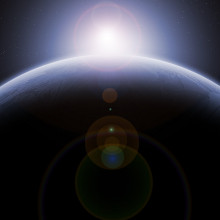
37:03 - How are exoplanets named?
How are exoplanets named?
Chris put this question to David Rothery from the Open University...
Chris - There were 7 ones that were discovered recently, you were talking about them earlier, they’re called TRAPPIST-1a-f, which we thought were a little boring, so we asked you for your suggested names on twitter and Facebook…
Some of my favourites:
Planety Mcplanetface from Stephen on Facebook
Colours of the rainbow - Odysseus on FB
Seven dwarves from Marius on FB
Jeremy wants to name them after types of alcohol
But actually, how do scientists do this? How do you come up with names for these exoplanets?
David - The scientific designation for exoplanets are that the follow the name of the star or the catalogue number of the star. The first exoplanet that you find of a star you never use the letter ‘a’. You could started with ‘b’...
Chris - David Bowie - that would be a good star, wouldn’t it? Tina Turner… Rod Stewart...
David - Only for terrestrial planets because they need to be “rock stars!”
The Trappist planets are Trappist- b. Trappist-1, that’s a star. It was discovered and this star wasn’t even catalogued. It didn’t have a designation until it was studied. It was studied with a telescope called the transiting planets infrared survey telescope or something like that. So from that you can get Trappist, and the first star that they studied Trappist-1, the first star that the found to have planets going around it. They then found seven planets in total which are: Trappist-1b, c, d, e - all the way to h, or however many seven letters goes. Those are the scientific names, scientific designations.
A few years ago (2014 I think) the International and Astronomical Union, the same body responsible for trying to define what planet it is in this solar system said “OK. Let’s see about giving some names to some of these planets.” Now if any of you are offered to buy the name of a planet for a loved one as a birthday present - don’t, it’s a con! Nobody else will recognise this. The IAU said “let’s try out some names.” It puts out a call for names and I’m sure there’ll be a call for the Trappist planet names because it is a very close star.
It wasn’t open to the public, it was open to astronomical societies and the like. The Astronomical Society of Lucerne in Switzerland - the 51 Pegasi, the first sunlight star to have a known Earth like planet, suggest the name Helvetios, which is to do with Switzerland. And they suggested the name Dimidium for its planet. And 51 Pegasi-b is now Helvetios and 51 Pegasi-b the planet is known as Dimidium. Now I couldn’t remember how dimidium goes with helvetios - I had to look it up. But I know that 51 Pegasi-b is a planet going around 51 Pegasi.
So I’m not sure of these names. We’re not meant to give scientific planet designations, they’re meant to be used in parallel. I don’t know that they will catch on. I think it’s a bit gimmicky. But there are now ways to give names to the stars and their planets and we’ll see what comes of it.
Chris - Anna?
Anna - Well it worked with the chemical elements.. We don’t just call them 1, 2, 3, 4, 5, 6, 7, and so on.
David - Yeah. But there are only 92 naturally occurring elements. We’ve got 3,000 stars with known planets and 4,000 known exoplanets - it’s something like that. And the numbers are just going to keep on growing, and growing, and growing.
Chris - Michael?
Michael - I just like the fact that one of your listeners suggested they should be named after types of alcohol because Trappist beer is a thing. And I believe that’s where the acronym was meant to homage. The Trappist order of monks are known for brewing their own beers.
David - Well, I dare say they had that in mind. I’ve seen some really contorted acronyms. This one isn’t bad - transiting planets infrared survey telescope. You can get Trappist out of that fairly simply. But maybe we start with really powerful, hot, short drinks close to the star and have nice cool drinks further away.
Chris - There’s one made with liquid nitrogen perhaps like in a nightclub. Those test tubey ones for the distant ones, far away from the star. I like that idea. I think I might propose it.
David - Feel free.
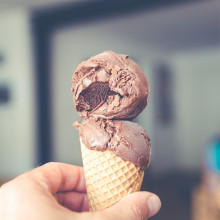
41:31 - Does climate affect sensitivity to brain freeze?
Does climate affect sensitivity to brain freeze?
Chris Smith put this question to biologist Aimee Eckert form the University of Sussex...
Aimee - I read something about this. And people who know more about this than I do believe that it's less to do with the weather and it’s more to do with the localised temperature change inside your mouth. But whether people who live in darkest Siberia or Australia are more resistant, or less able to cope with brain freeze, I’ve got no idea. But I know that if I was eating ice cream on a hot day or eating ice cream on a cold day, I’d still get brain freeze even if there was a big temperature difference between the ice cream and the weather.
Chris - So I can’t just change my geography and change my sensitivity to this.
Aimee - No.
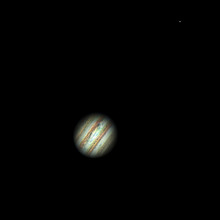
42:28 - Where does the energy come from to heat up Jupiter's moon Io?
Where does the energy come from to heat up Jupiter's moon Io?
Chris Smith put this question to planetary geoscientist David Rothery from the Open University, with a little help from materials scientists Anna Ploszajski from University College London...
David - It’s quite true - you can’t get something for nothing. I suspect Io’s orbit is actually increasing; it’s getting further from Jupiter and therefore orbiting more slowly and Jupiter’s spin will be slowing down very slightly as well. So these tidal interactions are robbing energy from the combined system of Jupiter and it’s moons.
Chris - So as the thing goes round Jupiter it’s getting squeezed and stretched a bit and that’s causing friction in the material of the moon, and that’s where the heating comes from in the moon?
David - You can try this at home. Get a metal coat hanger, bend it to and fro a few times, just touch it to your lips, you’ll burn your lips. Not badly but you’ll feel the heat. It’s this internal friction because of the tidal stressing and it does the job. But the energy’s coming from Io’s orbit and Jupiter’s spin.
Chris - Anna…
Anna - So what you’re doing there when you’re bending the coat hanger is you’re manipulating the atoms inside the metal and the metal in this case, is behaving a bit like a plastic, so it’s very pliable. The reason is heats up is because the atoms as they slide over each other in their atomic planes are rubbing against each other. And yeah, you're right, that’s where friction comes from and so it gets released in heat.
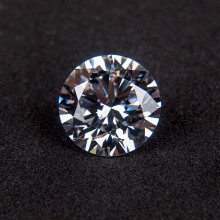
44:11 - Why do razors go blunt, but diamonds don't?
Why do razors go blunt, but diamonds don't?
Chris Smith put this question to materials scientist Anna Ploszajski from University College London...
Anna - This is a brilliant question and it’s archetypal material science, so I’m in my element here.
A razor blade is usually made of a metal and it’s usually made of stainless steel. Now metals are made of crystals, funnily enough. What we mean by that is that in a crystal all of the atoms are lined up in a very 3D orderly pattern. Now in a single razor blade there are billions of tiny, tiny, different crystals. We call these crystals actually grains, and under a microscope they’ll look like crazy paving, so all of the different grains are orientated crystals, orientated different to each other.
At the very tip of a razor blade, every time that collides with a hair, it creates a little dent because the atoms at the tip are not very strongly bonded together, and so even the force of a hair colliding with them will cause them to reshuffle and over time this causes blunting.
The reason I was talking about the grains and the tiny crazy paving crystals earlier was that the points at which they meet are the weakest points in the material. So the fact that there are lots and lots of these grain boundaries, means that a razor blade is more likely to have its atoms disrupted by even something as gentle as a hair.
In contrast, a diamond - diamonds are made of carbon and these carbon atoms are bonded very, very strongly to four others. This is a very stable and a very strong structure. Diamond is actually the hardest material that we have, and it’s down to these carbon bonds. In the case of a diamond that wouldn’t go blunt, it’s probably also because it’s a single crystal so it doesn’t have any of those grain boundaries, and so no weak points in its atomic structure.
Chris - Basically, if I keep rubbing a diamond up and down a piece of glass for example, I shouldn’t get any loss or damage of the diamond crystal. It’ll be the glass that pays the price all the time?
Anna - Absolutely. So what we’re looking at here is the hardness of the materials and diamond is the hardest material that we have. So it would always wear away the glass rather than the diamond, yes.

46:47 - Are men with more facial hair more fertile?
Are men with more facial hair more fertile?
Chris Smith put this question to biologist Aimee Eckert, from the University of Sussex...
Aimee - Well, the short answer is no. Whilst it’s true that the hormone, testosterone, which everybody produces (men and women), is responsible for beard growth. Men all have a similar amount of testosterone but it’s your individual sensitivity to testosterone that’s different and that is shaped by your unique genetics. A bit like how everyone’s a different height, everybody’s sensitivity to testosterone is a little bit different.
There’s an enzyme that turns testosterone into something call dihydrotesterone, and it’s this form of the hormone that affects people’s hair. This eventually causes, well it can do if you’re very sensitive to testosterone, it can cause the hair follicles on a man’s head to shrink in some people.
So sorry Mike, you’re very sensitive to testosterone. But it’s amazing how it doesn’t affect the follicles on the chin. Like I can see Mike is perfectly capable of growing a beard.
Chris - He’s just got his head on upside down. That’s what it is.
Aimee - So, yeah. It’s the sensitivity to testosterone. A man with a full beard is not going to have more or better quality sperm.
Chris - Sorry to burst your bubble there David.
David - Well, I’d just like to point out that the reason I have a beard is that I can’t afford a diamond tip razor to shave with.
Chris - But presumably, Anna, if you did shave with a diamond razor, then you wouldn’t end up having to keep replacing your frazor every five minutes, which is what inevitably happens? You get about three shaves and then they’re blunt. It wouldn’t blunt.
Anna - Yeah. Technically, it wouldn’t blunt although I think you’d struggle to get a diamond at a very, very sharp angle like you can with a razor blade
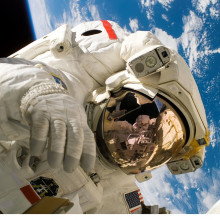
48:45 - At what height above Earth is zero-gravity?
At what height above Earth is zero-gravity?
Chris Smith put this astronomical question to the Open University's David Rothery...
David - I think there might be a misconception here that, as you get further and further away from the Earth, you’re feeling less of a gravitational pull and at some point you stop feeling the pull of the Earth’s gravity. That’s not what happens!
If you double your distance from the centre of the Earth, the gravity would decrease to a quarter of what it is at the surface, but that’s not zero G.
Zero G in space is because you’re in a space capsule accelerating under gravity, orbiting the Earth, or going from one body to another and you’re not accelerating [relative to the spacecraft]: the person within the spaceship is accelerating at the same rate as the vessel. So it’s like the lift dropping down the lift shaft. So zero G is not distance away from the Earth.
Chris - So people who are on the International Space Station, the reason that they are in orbit around the Earth is because gravity is hanging onto them and keeping them in orbit? But they’re just free-falling around the Earth all the time so that they’re weightless, but that’s not the same as zero G?
David - Correct. They’re in freefall. They’re still experiencing the Earth’s gravity but so is the spaceship that they’re in. So, between them and the space ship, there’s no acceleration.
Chris - Let’s take it to it’s logical conclusion; the reason that Pluto is 6 billion kilometres from where we are here on Earth and it’s still orbiting the Sun is because the Sun’s gravity is hanging onto Pluto, even though it’s that far away. And gravity does get weaker with distance, but there’s still enough to hold onto Pluto and things beyond it.
David - Absolutely!
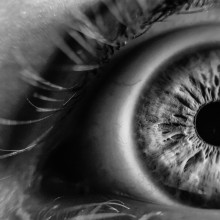
50:31 - How many photons does it take to see an object?
How many photons does it take to see an object?
Chris Smith asked Physicist Michael Conterio to illuminate us on the subject...
Michael - So a photon is, we call it a particle of light. Because, in quantum physics, light is not just a wave it also can be divisible into these particular chunks of energy, and we call each one of those for light, a photon. You can’t have half a photon but what you can have is photons of different frequencies. So for different types of light it will have a different frequency, and a different amount of energy per photon. The cells in our retina are good at basically detecting particular types of photon, those in visible light. Not quite sure what you need in order to get a coherent image. It’s really hard to measure how many photons there are because they’re reacting with your eyes and, therefore, not going to set off whatever detector that we’re using.
Chris - Yeah. So, obviously, if you were to detect the photon you couldn’t, by definition, then expose your eye to it? You’ve got to sort of try and work out some way of saying well you know roughly how many photons must be arriving in the eye to trigger a response in the retina?
Michael - Yeah, precisely. But we think that when you’re getting down to the order of single digit numbers of photons, you can just about detect one or a few photons. It’s kind of a bit ambiguous there but you don’t recognisably see anything, it’s just like I think there was something there… maybe. But tens of photons you pretty much can and hundreds of photons, yes definitely.
Chris - What is the retina doing in order to enable you to detect these packets of energy (the photons) arriving on the retina?
Michael - When you get the photon arriving you’re basically transferring the energy from that photon to an electron in the retina, and that creates a signal that can then be interpreted by your brain as having seen some light. The thing is it’s not all photons that can do this. Some of them don’t have enough energy in order to actually bump that up.
We’re getting into chemistry here... you actually get some energies which the electron can’t jump up, so this is how your red, green, and blue cones in your retina which will each respond to a different, effectively, sized photon a different amount of energy in the photon. So some of them will just go straight past. Some of them, like ultraviolet light, you won’t detect as light; you won’t get the right sort of signal. But they can cause the electron to jump up a lot of energy and that will actually start causing damage in your eye because you’re now got a loose electron wondering about which can start doing damage to the cells in your eye.
On the other hand you have things like microwaves and radio waves, where the photons have lower energy and they just go straight through without interacting with it. There are lots and lots of photons going through your eye that you just never notice. So it’s kind of hard to say what’s the maximum number? It depends on the type of photon. UV ones will be causing damage; radio waves will just be going straight through.

53:54 - What happens to your body during a marathon?
What happens to your body during a marathon?
Chris Smith put biologist Aimee Eckert from the University of Sussex through her paces...
Aimee - Yes. Apart from getting tired. Oh, there’s a lot of things. Because you’re running for such a long distance you’re going to use up all the glucose reserves in your blood, in your muscle cells, and also in the carbohydrate stores in your liver.
Carbohydrates is your body’s preferred source of energy and once you deplete all of that your body starts working on fat cells and also muscle cells. So that is going to lead to you feeling incredibly tired, incredibly sore, and the phenomenon called the ‘runner’s wall.’ People describe that as a complete inability to continue and being really unable to focus on anything.
Another thing that happens is you loose a lot of fluid, obviously, through sweating and when you complete a marathon you arrive over the finish line (hopefully) 2 centimetres shorter than when you started because you’ve lost so much fluid between the discs in the vertebrae of your spine. But, if you rehydrate properly, you’ll be back to normal in 24 hours.
Chris - Is this something you spotted on YouTube as well or is that a fact that actually, people are 2 centimetres shorter after a marathon?
Aimee - I don’t know what you’re trying to say about my scientific credentials, but I’ve done my homework Chris.
Chris - I’m just referring to your kitten data. So Mo Farah is 2 centimetres shorter, on average, after he completes the London Marathon in record time?
Aimee - Yes.
Chris - Goodness! And does he inflate again? Presumably he does, otherwise he’d be miniscule by now wouldn’t he with the number of marathons he’s run?
Aimee - Yeah. Rehydrate and you’ll be back to normal,yeah, to your original height.
Chris - And what other effects are there - anything else?
Aimee - Yeah. There’s a few more things. Your body needs oxygen to work and do all that exercise so that’s loads of airflow going through your respiratory tract. This really dries out your nose and so the mucus producing cells in your nose work really, really hard and so your nose will be running a lot, as well as your feet!
Your immune system gets suppressed. I’ve heard from runners that they often get a bad cold after doing a marathon. I’m not sure why your immune system gets suppressed in this way; maybe it’s trying to deal with the inflammation in the body from broken and injured muscle cells.
Chris - This all sounds like bad news. Is there evidence that marathon runners ultimately end up less healthy than the average person, because this doesn’t sound like a recipe for being healthy?
Aimee - I think it’s pretty extreme exercise, yeah.
Chris - So... with care?
Aimee - Yeah.
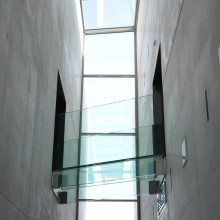
56:44 - How do glass bridges support our weight?
How do glass bridges support our weight?
Chris Smith put this cracking question to University College London materials scientist Anna Ploszajski...
Anna - Well, actually it is glass. But they’ve done two things to treat this glass so that it is safe for you to stand on a piece of glass hundreds of metres up in the air and be perfectly safe.
The two things that they do is they toughen it. Now have your heard of an experiment called a “Prince Rupert’s drop?" This is a very famous experiment done with glass. What you do is you take a drop of molten glass and you plunge it very, very quickly into cold water. Now what this does is it has the effect of putting the outer layer of that glass under, very, very intense mechanical compression. It’s the action of cooling down so quickly that puts the atoms into compression. This means that if you try and put a crack into the surface of that glass, the atoms will just close it up again. It’s very, very difficult to get a physical crack into something that is under such intense compression.
Now as we know, physics requires an equal and opposite reaction to a force, so the middle of the Prince Rupert’s drop is in very, very intense mechanical stress tensile stress. So those atoms are being pulled away from each other very, very strongly as well. So yes, you can hit this glass with a sledgehammer and it will be very unlikely to break.
The second thing that they do is - this is bulletproof glass and it is a glass laminate construction. So this glass is layered and there’s layers of plastic in between the layers of glass. What happens in bullet-proof glass is that when a projectile, or a person's foot, or a sledgehammer tries to hit the glass then that first layer is probably going to smash. That absorbs a lot of the energy in the bullet or in the sledgehammer and then that glass presses down into the plastic layer, and that plastic layer flows like a thick, treacly fudge-type thing and that absorbs a huge amount of the energy and spreads the impact over a very wide surface area. If there’s still any more energy in the sledgehammer after that, the next layer of glass might smash and then spread its energy over the next layer of the plastic. This process continues until the bullet or the sledgehammer has stopped, and that’s why you can’t fall through the glass.
Related Content
- Previous What causes deja vu?
- Next Why do I get a stitch when I run?





Comments
Add a comment